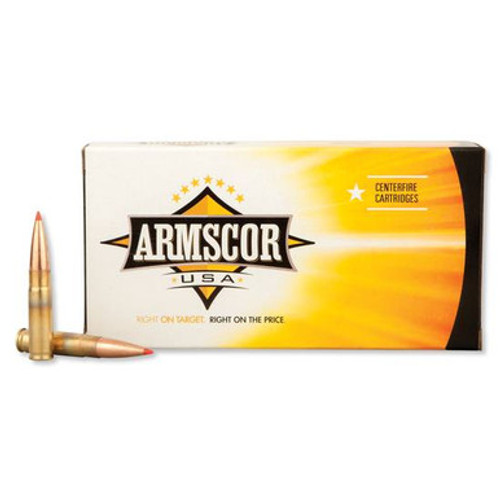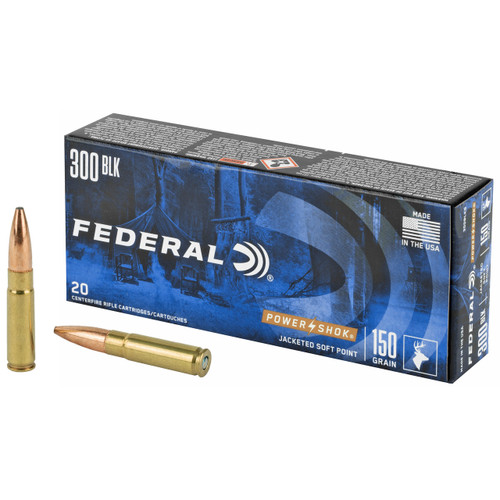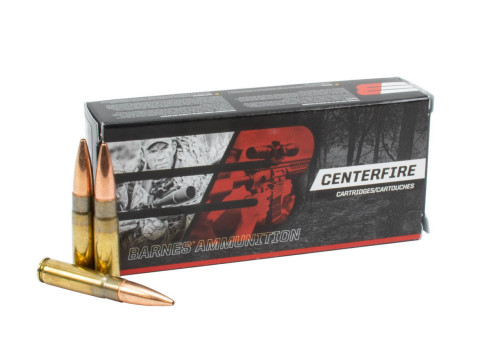300 AAC Blackout Ammo

.300 AAC Blackout: In Depth
Firearms history is full of passionate people who operated outside of the mainstream – individuals who weren’t afraid to innovate despite having limited resources or a lack of industry support. In the case of small arms – such as rifles, carbines and pistols – a single determined individual could make a radical and long-lasting contribution to a weapons platform with a little bit of time and the right tooling, and often did.
During his long career, one such enthusiast set about developing a .30 caliber cartridge that was accurate when subsonic and silenced while also capable of shooting lighter bullets accurately at supersonic velocities. This innovative work was carried out by J.D. Jones in late 1992, and the cartridge he developed was known as the .300 Whisper. It was .30 caliber, as the name would imply, and sat inside a necked-up .221 Fireball case. Fun fact: the .221 Fireball and .223 Remington have the same parent case (.222 Remington). Some other notables about this round: it was designed to feed through an M16 platform as well as work in short-barrelled bolt guns or single shot pistols, it could be used to hunt varmints up to medium-sized game, and it was low recoiling. All this it achieved in addition to running quietly when suppressed: especially with heavy 220-gr. bullets. The .300 Whisper flourished among competition pistol shooters, hunters, suppressor lovers, and anyone else who could either buy the ammo or load it themselves.
Years later, discussions between the folks at AAC (Advanced Armament Company) and a “military customer” (who happened to be in pursuit of a new .30 caliber cartridge for the M16 platform) led these two parties right to the .300 Whisper, and it’s not hard to see why: .300 Whisper could use the same bolt and mags as a 5.56 NATO M16, and it was .30 caliber! However, due to a certain ammunition manufacturer’s (Remington’s) requirements, AAC needed to work with SAAMI to develop and register what was essentially their own version of the .300 Whisper before production could commence. After AAC and Remington completed development, their new cartridge was nearly indistinguishable from the Whisper. The result bore AAC’s name along with a nod to the .300 Whisper – and the ultimate mission of running suppressed – .300 AAC Blackout.
The new round, like the .300 Whisper, could be loaded with a wide variety of bullet weights. Most common were 125-gr. supers and 220-gr. subs. As stated before, it worked perfectly in the actions of M16s / AR-15s and could even be loaded in the same magazines that .223 Remington / 5.56x45mm NATO used. Better still, it was an effective cartridge – for its intended mission – even when fired from a short (8” - 10”) barrel, keeping the weapon’s overall length short when a suppressor was added. This last quality has been responsible for the many pistols and PDWs chambered for this cartridge since its introduction.
As a relatively young cartridge, .300 AAC Blackout is still carving its niche among shooters, though it remains a top choice for CQB-style guns that run subsonic, suppressed loads. In addition, lighter weight loads are becoming popular options for hunters in all kinds of carbines and pistols. Ultimately, though, its compatibility with the AR-15 means this round will be relevant for many years, regardless of which application you might choose.
.300 AAC Blackout: Guns
First and foremost, as this cartridge was envisioned to run in an M16 / AR-15 platform, there’s a lot of those guns to choose from. Also, newer pistol-length semi-auto PDW designs, and bolt guns are available. A fully-featured, suppressor-ready, tactical .300 AAC Blackout rig will likely have a very short barrel, whereas bolt-actions are typically carbine length (16” is common).
SBRs / Pistols
- Maxim Defense MDX:510 SBR
- CMMG Dissent MK4
- Sig MCX Spear
- B&T APC300 PRO
- DDM4 PDW
Semi Auto Rifles
- Wilson Combat Protector Carbine
- Ruger Mini-14 Tactical
- Desert Tech MDRX
Bolt Action Rifles
- Ruger American Ranch
- Savage Axis II
- Christensen Arms Ridgeline Scout
- Mossberg MVP
Why Choose .300 AAC Blackout?
There’s a handful of really compelling use-cases for this cartridge. For one, if suppressors and/or SBRs are legal to own in your area, you need to check it out. Also, anyone looking for a predator and varmint cartridge that slings larger projectiles will find a decent option here, since there are plenty of hunting loads. Finally, it’s not a bad choice for home defense – especially if you can get it into the shorter-barreled AR platform where it thrives.
Suppressed Shooting
- The cartridge was designed to be used with suppressors.
- Subsonic loads are hearing safe with a suppressor.
Hunting
- Light-for-caliber supersonic rounds are the better choice for hunting. Many hunting loads are available.
- Great for predator and varmint hunting out of an AR platform with the 110-gr. to 125-gr. projectiles.
- While nowhere near the velocity of .308 Winchester or .30-06 Springfield, this is another .30 caliber option for medium sized game at shorter distances.
Home Defense
- Low recoil regardless of load.
- Cartridge is effective from a short barrel firearm, which can be easier to maneuver in an HD situation.
- Hearing safe with subsonic loads and a suppressor, though this combo may be prone to overpenetration.
.300 AAC Blackout: Ammo Brands and Loadings
Remington kicked things off with the 220-gr. JHP load back in 2011, which was designed to be suppressed. However, there’s nothing stopping you from suppressing supers too, they just won’t be hearing safe. Supersonic loadings featuring the lighter bullets are very popular for hunting varmints up through medium-sized game. As always, make sure the bullets in your chosen load will expand properly if you’re going to hunt. This will vary depending on the particular bullet and the velocity it achieves through your barrel.
Brands
- Federal, Remington, Winchester, Hornady, Ammo Inc., Barnes, Armscor, Sierra, Fiocchi, Nosler, Sellier & Bellot, Underwood
Standard Loadings
- 125-gr. Polymer Tip @ 2,200/fps - Hunting
- 220-gr. JHP @ 1,020/fps - Subsonic
Bullet Types
- FMJ (Full Metal Jacket) - Target
- Polymer Tip - Hunting, target
- JHP (Jacketed Hollow Point) - Target
- HP (Solid Hollow Point) - Hunting
Bullet Weights
- 110-gr. - Hunting, defense, target
- 125-gr. - Hunting, defense, target
- 220-gr. - Subsonic, defense, target
Velocities
- 110-gr. - 2,350/fps
- 125-gr. - 2,200/fps
- 220-gr. - 1,020/fps
Subsonic Ammo
- Here’s where this cartridge really shines: heavy-for-caliber bullets – usually 190-gr. and up – at about 1000/fps.
- Popular for home defense when paired with a suppressor.
- Not ideal for hunting due to low velocity – bullet expansion is usually not as dependable. This varies from bullet to bullet though, as some are designed to expand at lower velocities.
Barrel Length and Twist Rate
- This topic can be pretty complex. Consider checking out this video for a deeper dive.
- Generally, if you have a carbine length barrel @ 16”, a 1:8 twist will stabilize anything you’re likely to shoot. Twist rates such as 1:5, 1:6, and 1:7 are all available depending on how short you want to go. Make sure your barrel length, twist rate, and preferred bullet weight/length are all compatible. Check with the firearm manufacturer or barrel maker for more info.
.300 AAC Blackout FAQ:
.300 AAC Blackout is also written as .300 BLK. .300 Whisper is a different cartridge with very similar dimensions. While some folks used to worry about interchangeability of firearms and ammo between them, .300 AAC Blackout is so dominant now that you’re unlikely to run into .300 Whisper at all.
Yes. This is a very effective close-range cartridge, made even better by a short barreled gun – ideally with a suppressor. Tons of PDWs / pistols / SBRs are chambered for this cartridge. Compared to AR-platform mainstay .223 Rem/5.56 NATO, .300 AAC Blackout carries more energy and loses less velocity out of shorter barrels.
Definitely. 110-gr. and 125-gr. loads are popular for varmint, predator, and deer hunting. Most 220-gr. subsonic loads will not reliably expand – though there are some that are better than others. Make sure you pick a load with the proper bullet for your intended game that will expand at lower velocities if you are going to hunt with the heavy-for-caliber stuff.











